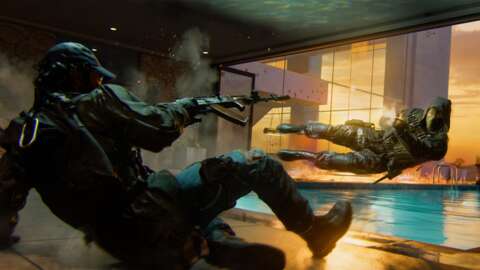NBA 2K25 is just a few weeks away, and the team at Visual Concepts is kicking off a multi-week preview of the game today. This first of several unveilings looks at the most important part of the game: on-court play. For 2K25, the studio has committed more resources to expanding ProPlay, the game’s unique animation system that translates real-life NBA footage into animations in-game.
This starts with what the team calls “the biggest change to our gameplay engine in many years,” the all-new dribble engine. In all past versions of NBA 2K, dribbling the ball was pre-scripted and manually programmed using a library of mocapped animations. But starting with 2K25, that’s no longer the case.
Now dribbling is led by ProPlay and its ability to turn game tape into gameplay. The 2K team says “stops are higher, launches are more explosive,” and the feature brings more lifelike gameplay to the series across every inch of the court. Similar to Madden NFL 25’s Boom Tech, the new NBA 2K25 dribble engine seems like an idea that is hard to express but easy to understand once it’s in your hands.
New features on offense
Flanking that headlining tech upgrade, NBA 2K25 also comes with a host of new mechanics on offense and defense. Let’s start with the former. New to the game this year are tools such as shot canceling, signature go-to shots, shot-timing profiles, Pro Stick rhythm shooting, and more.
The signature go-to shots are, like so much else, powered by ProPlay. This new feature allows players to exercise new dribble-into-shot combos translated from NBA footage. This is done rather simply by holding up on the Pro Stick. Shot canceling allows players to transition from one shooting animation to another at the last moment, adding a new weapon to the offense’s repertoire.
Shot-timing profiles come as a response to last year’s intent to make shooting a more focused, sometimes difficult, process. These new profiles let players customize their shot-timing windows, thereby tweaking the risk-reward system.
For players choosing “low risk-reward,” shot-timing will be more forgiving, emphasizing ratings, openness, and shot selection. A mistimed shot may still go in, but this option will make it harder to have consistently excellently timed shots because the green window will be smaller. Still, it solves the issue many had last year of non-green attempts missing the bucket. The inverse, “high risk-reward,” comes with more difficult shots, resulting in green-or-miss outcomes–essentially what 2K24 offered, much to some players’ dismay.
2K25’s shot enhancements could turn you into the next Curry.
New options for shot-taking visual cues also allow players to customize their ideal jump-shot release point, expanding on last year’s Shot Creator suite. Essentially, players can decide when they release the ball in their custom animation, letting them grow more comfortable and in tune with the animation’s timing window for hitting the perfect green beans.
A new touch to the Pro Stick, rhythm shooting, brings even more nuance to a shot’s timing window from start to finish, as it demands players point the Pro Stick down to start the shot, then up when the animation reaches its Set Point. Visual Concepts revealed that, at first, many on the team found the new mechanic too difficult, but that those who stuck with it grew to appreciate it and now have a hard time reverting to the previous Pro Stick shooting style.
New features on defense
With all the new toys for offense, the defense is being buffed to reliably counter the attack. This starts with a new movement system that gives defenders the same fluid movement as offensive players by using the right stick. This allows for faster, tighter defensive cutoffs, leaving players less likely to get burned by a Pro Stick all-star with the ball in their hands.
Contested shots will now use a dynamic weighting system rather than the fixed one in previous games. This means more nuance in how contested a shot will be based on the defense’s coverage at the start of a shot versus its release. To that end, ratings for perimeter and interior defense, as well as height, will be more important and directly affect outcomes.
AI teammates have been improved to better account for both real-world spacing differences mimicked in-game, as well as user freelancing. In short, your AI teammates should more often be where they’re supposed to be based on the offense’s formation, with over 20 new spacing adjustment locations inside the perimeter.
Playbook sharing and new tutorials
In 2K25, players can now create and share custom playbooks with the community, which will likely lead to new metas emerging in various competitive modes. If you need more help than that, however, the new Learn 2K mode offers a complete walkthrough of everything there is to learn about playing 2K, from the simplest mechanics to mastering all the new features mentioned above.
Learn 2K mode is built for beginners, intermediates, and experts alike.
Roadmap ahead
Lastly, this is just day one of NBA 2K25’s preview season. In the weeks to come, Visual Concepts will be sharing a lot more with GameSpot and the community at large regarding what players can expect when they tip off in September. Here’s what’s next:
Week of August 5: MyPlayer and MyCareerWeek of August 12: MyNBA and The WWeek of August 19: MyTeamWeek of August 26: The CityWeek of September 2: Season 1 preview and 2KBeats soundtrack revealSeptember 4: Early access period beginsSeptember 6: Global launch of NBA 2K25
If you’ve already seen enough to merit your purchase, we have all the details on how to preorder NBA 2K25 and what you’ll get as bonuses from various retailers.



